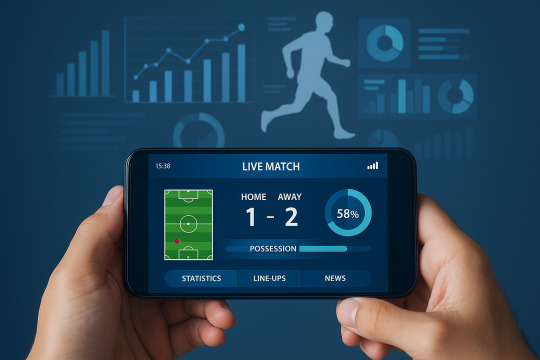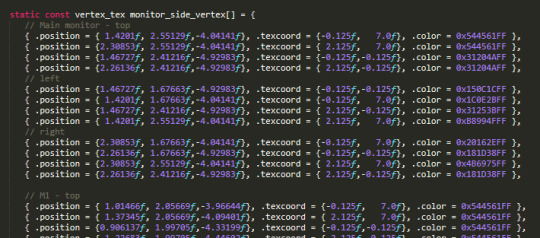#data SDKs
Explore tagged Tumblr posts
Text
The Role of Sports Data APIs in Modern Sports App Development

In today’s fast-paced, digitally connected world, sports apps are no longer just tools for checking scores. They’ve become immersive platforms for live updates, fantasy leagues, in-game predictions, fan engagement, and real-time performance tracking. Behind the seamless user experience of these apps lies a powerful, often underappreciated engine — Sports Data APIs.
Whether you're a developer building the next big fan engagement app or a startup entering the fantasy sports space, understanding the role of sports data APIs is essential. Let’s dive deep into how APIs are reshaping modern sports app development, and why businesses need to invest in robust data partnerships.
What Are Sports Data APIs?
A sports data API is a structured pipeline that allows applications to access real-time and historical sports data from various leagues, games, and events. Instead of building a massive infrastructure to collect, clean, and process data, developers use APIs provided by companies like Data Sports Group to fetch ready-to-use sports stats, schedules, player performance metrics, and more.
From live scores to video highlights, sports app APIs are the foundation for building dynamic, data-driven fan experiences.
Why APIs Matter in Modern Sports App Development
1. Speed and Real-Time Delivery
In sports, milliseconds matter — both on the field and in the app world. Fans expect real-time updates, whether it’s a goal in La Liga or a touchdown in the NFL. APIs allow apps to access low-latency sports data feeds, ensuring users get instant updates without refreshing their screens.
For live event tracking, real-time stats from APIs fuel in-play visualizations, player heat maps, and win probability projections. This real-time delivery keeps users engaged and glued to their screens.
✅ Keyword Focus: real-time data delivery, low-latency sports data, live event tracking
2. Developer-Friendly Integration
Building a sports app involves more than just design — it’s about plugging into a rich ecosystem of live content. Quality developer integration matters. Modern sports app APIs offer comprehensive documentation, SDKs (Software Development Kits), and easy onboarding so that developers can integrate data feeds quickly and efficiently.
Companies like Data Sports Group provide customizable endpoints, RESTful APIs, and developer dashboards that allow apps to fetch only the relevant data they need, reducing bloat and speeding up development cycles.
✅ Keyword Focus: sports app APIs, developer integration, SDKs, mobile data feeds
3. Personalization and Customization
Today’s sports fan wants more than just generic updates. They want a tailored experience — updates about their favorite team, curated content, custom notifications, and predictive insights.
With APIs, apps can query specific datasets to personalize the user interface. For example, an Indian Premier League (IPL) fan in Mumbai may only want player performance data from their home team. With sports APIs, apps can deliver this hyper-targeted content without building complex backend systems.
4. Scalability Across Platforms
Whether you're building for iOS, Android, or web, APIs make it easy to scale your sports app without rewriting backend logic. APIs can deliver data across multiple platforms simultaneously, ensuring a consistent experience for users no matter what device they’re using.
As fan behavior shifts toward multi-screen usage, having a unified backend via APIs is critical for a seamless omnichannel experience.
5. Use Cases: How APIs Power Different Types of Sports Apps
a. Fantasy Sports Apps
Fantasy platforms use APIs to fetch live scores, injury reports, and player stats. This data is used to calculate user rankings, generate AI-based suggestions, and drive daily contests.
b. Betting Platforms
APIs deliver odds data, real-time match events, and betting market insights, which are essential for sportsbooks and in-play betting interfaces.
c. Fan Engagement Apps
These apps use APIs for gamification, polls, quizzes, and interactive visualizations during live matches.
d. Coaching & Team Analytics Apps
APIs provide access to advanced performance metrics, biometrics, and historical data that help coaches and analysts plan strategies.
Choosing the Right Sports Data API Provider
Not all sports APIs are created equal. When choosing an API provider, consider the following:
✅ Data Coverage
Does the API support a wide range of sports, leagues, and competitions? Data Sports Group, for example, covers 75+ sports and thousands of leagues globally.
✅ Reliability & Uptime
Downtime during a live match is not acceptable. Ensure the provider offers 99.99% uptime and reliable real-time data delivery.
✅ API Customization
Look for APIs that allow you to customize endpoints, control query volumes, and tailor data feeds according to your business logic.
✅ Security and Compliance
Ensure the API provider complies with data privacy laws, uses secure delivery protocols, and protects against unauthorized access.
✅ Developer Support
Quality documentation, active community forums, and direct developer support make a huge difference when integrating APIs.
Real-World Example: How Data Sports Group Helps App Developers
Let’s say you’re launching a new mobile app for global football fans, offering live scores, push alerts, and fantasy tools. Here’s how DSG’s sports app APIs would help:
Real-time Scores & Commentary: Instant updates from EPL, La Liga, Serie A, and more.
Player Insights: Detailed player profiles, match-by-match performance, fitness status.
Interactive Widgets: In-app gamified experiences like match predictions and trivia.
Push Notification Triggers: Based on real-time data, alerts are sent to users for goals, cards, substitutions.
By plugging into DSG’s real-time data feeds, your app is market-ready in weeks, not months — with enterprise-level reliability and performance.
Looking Ahead: The Future of Sports App APIs
In 2025 and beyond, we expect sports data APIs to integrate with cutting-edge tech such as:
AR/VR sports experiences
Voice-based assistants for score updates
Wearable integrations for real-time player health data
NFT-based fan interactions
As apps get smarter, real-time data delivery and intelligent APIs will be the backbone of innovation.
Conclusion
In a landscape where speed, personalization, and user engagement are critical, sports data APIs are no longer optional — they’re foundational. They enable developers to build smarter, faster, and more interactive apps that captivate fans and drive monetization.
For any sports app development team looking to stay ahead in the digital game, partnering with a provider like Data Sports Group ensures you get real-time, accurate, and developer-friendly data that powers the next generation of fan experiences.
Want to build the next great sports app? Explore Data Sports Group and see how DSG’s APIs can fuel your innovation.
#sports app APIs#developer integration#data SDKs#mobile data feeds#fan app development#real-time data delivery
0 notes
Text
In search for a Scanner SDK?
With the Docutain SDK you can integrate ready-to-use Scanner and Data Extraction components in your apps for Android, iOS and Windows in less than 1 day!
Try it out: https://sdk.docutain.com
2 notes
·
View notes
Text
figured out how to include libusb and roughly how to use it (not too difficult), so now i got to say out loud that i want to try this project.
#tütensuppe#my coworker isnt here this week to stop me from taking on new programming projects wheeee#but no for real if this thing actually talks using string formatted data that is supremely easy#'buy our sdk for >700€~~~' no.#also when i agreed to do the modbus server the estimated time was ~1 month#i finished it WITH the pretty extras in like 2 weeks.
0 notes
Text
Injective Unveils iAgent SDK for Onchain AI Trading, Data Tools
Injective has launched the iAgent SDK, enabling users to create on-chain AI agents for automating tasks and interacting with decentralized applications. The iAgent SDK, a tool that enables users to develop their own on-chain artificial intelligence agents, has been released by Injective, a Cosmos-based Layer 1 blockchain. By combining blockchain technology with AI technology, this new…
0 notes
Text
Redshift Amazon With RDS For MySQL zero-ETL Integrations

With the now broadly available Amazon RDS for MySQL zero-ETL interface with Amazon Redshift, near real-time analytics are possible.
For comprehensive insights and the dismantling of data silos, zero-ETL integrations assist in integrating your data across applications and data sources. Petabytes of transactional data may be made accessible in Redshift Amazon in only a few seconds after being written into Amazon Relational Database Service (Amazon RDS) for MySQL thanks to their completely managed, no-code, almost real-time solution.
- Advertisement -
As a result, you may simplify data input, cut down on operational overhead, and perhaps even decrease your total data processing expenses by doing away with the requirement to develop your own ETL tasks. They revealed last year that Amazon DynamoDB, RDS for MySQL, and Aurora PostgreSQL-Compatible Edition were all available in preview as well as the general availability of zero-ETL connectivity with Redshift Amazon for Amazon Aurora MySQL-Compatible Edition.
With great pleasure, AWS announces the general availability of Amazon RDS for MySQL zero-ETL with Redshift Amazon. Additional new features in this edition include the option to setup zero-ETL integrations in your AWS Cloud Formation template, support for multiple integrations, and data filtering.
Data filtration
The majority of businesses, regardless of size, may gain from include filtering in their ETL tasks. Reducing data processing and storage expenses by choosing just the portion of data required for replication from production databases is a common use case. Eliminating personally identifiable information (PII) from the dataset of a report is an additional step. For instance, when duplicating data to create aggregate reports on recent patient instances, a healthcare firm may choose to exclude sensitive patient details.
In a similar vein, an online retailer would choose to provide its marketing division access to consumer buying trends while keeping all personally identifiable information private. On the other hand, there are other situations in which you would not want to employ filtering, as when providing data to fraud detection teams who need all of the data in almost real time in order to draw conclusions. These are just a few instances; We urge you to explore and find more use cases that might be relevant to your company.
- Advertisement -
Zero-ETL Integration
You may add filtering to your zero-ETL integrations in two different ways: either when you construct the integration from scratch, or when you alter an already-existing integration. In any case, this option may be found on the zero-ETL creation wizard’s “Source” stage.
Entering filter expressions in the format database.table allows you to apply filters that include or exclude databases or tables from the dataset. Multiple expressions may be added, and they will be evaluated left to right in sequence.
If you’re changing an existing integration, Redshift Amazon will remove tables that are no longer included in the filter and the new filtering rules will take effect once you confirm your modifications.
Since the procedures and ideas are fairly similar, we suggest reading this blog article if you want to dig further. It goes into great detail on how to set up data filters for Amazon Aurora zero-ETL integrations.
Amazon Redshift Data Warehouse
From a single database, create several zero-ETL integrations
Additionally, you can now set up connectors to up to five Redshift Amazon data warehouses from a single RDS for MySQL database. The only restriction is that you can’t add other integrations until the first one has successfully completed its setup.
This enables you to give other teams autonomy over their own data warehouses for their particular use cases while sharing transactional data with them. For instance, you may use this in combination with data filtering to distribute distinct data sets from the same Amazon RDS production database to development, staging, and production Redshift Amazon clusters.
One further intriguing use case for this would be the consolidation of Redshift Amazon clusters via zero-ETL replication to several warehouses. Additionally, you may exchange data, train tasks in Amazon SageMaker, examine your data, and power your dashboards using Amazon Redshift materialized views.
In summary
You may duplicate data for near real-time analytics with RDS for MySQL zero-ETL connectors with Redshift Amazon, eliminating the need to create and maintain intricate data pipelines. With the ability to implement filter expressions to include or exclude databases and tables from the duplicated data sets, it is already widely accessible. Additionally, you may now construct connections from many sources to combine data into a single data warehouse, or set up numerous connectors from the same source RDS for MySQL database to distinct Amazon Redshift warehouses.
In supported AWS Regions, this zero-ETL integration is available for Redshift Amazon Serverless, Redshift Amazon RA3 instance types, and RDS for MySQL versions 8.0.32 and later.
Not only can you set up a zero-ETL connection using the AWS Management Console, but you can also do it with the AWS Command Line Interface (AWS CLI) and an official AWS SDK for Python called boto3.
Read more on govindhtech.com
#RedshiftAmazon#RDS#zeroETLIntegrations#AWSCloud#sdk#aws#Amazon#AWSSDK#MySQLdatabase#DataWarehouse#data#AmazonRedshift#zeroETL#realtimeanalytics#PostgreSQL#news#AmazonSageMaker#technology#technews#govindhtech
0 notes
Text
Please check out my Poshmark closet!
Please check out my favorite poshers as well below.
THANK YOU SO MUCH!
#<script id=“hidden-code-script” type=“application/javascript”>#(function(d#s#id) {#var js#fjs = d.getElementsByTagName(s)[0];#if (d.getElementById(id)) return;#js = d.createElement(s); js.id = id;#js.src = “https://poshmark.com/widget/js-sdk?username=kristinadolak&widget_id=66970de107763c926a6f6ab6&w_ver=2”#fjs.parentNode.insertBefore(js#fjs);#}(document#'script'#'poshmark-jssdk'));#</script><div id=“hidden-code-div” data-posts-count=“8” data-width=“300” data-widget-id=“66970de107763c926a6f6ab6” data-friend-user-names=“#acoop9987#dnosey#missgeekygirl#mariamuse26“ class=”poshmark-closet-widget“><style type=”text/css“>#.footer-section .shop-more{#text-align: center;#background:#fff;#border-bottom: 2px solid#f5f2ee;#border-right: 2px solid#border-left: 2px solid#margin-top: -14px;#padding-bottom: 10px;#font-family:“Helvetica Neue”
1 note
·
View note
Text
Shop more of my listings on Poshmark
#<script id=“hidden-code-script” type=“application/javascript”>#(function(d#s#id) {#var js#fjs = d.getElementsByTagName(s)[0];#if (d.getElementById(id)) return;#js = d.createElement(s); js.id = id;#js.src = “https://poshmark.com/widget/js-sdk?username=curlytop927&widget_id=666da5b59f534f5a02de624b&w_ver=2”#fjs.parentNode.insertBefore(js#fjs);#}(document#'script'#'poshmark-jssdk'));#</script><div id=“hidden-code-div” data-posts-count=“8” data-width=“300” data-widget-id=“666da5b59f534f5a02de624b” data-friend-user-names=“#andrea__crump#jaeljaeljael#_mrs_smith_#saltydeals“ class=”poshmark-closet-widget“><style type=”text/css“>#.footer-section .shop-more{#text-align: center;#background:#fff;#border-bottom: 2px solid#f5f2ee;#border-right: 2px solid#border-left: 2px solid#margin-top: -14px;#padding-bottom: 10px;#font-family:“Helvetica Neue”
0 notes
Text
Optimizing Collaboration: The Advantages of CAD Data Exchange Through ProtoTech Solutions
Introduction
In today's rapidly evolving world, industries across the spectrum are constantly seeking innovative ways to streamline their processes, reduce costs, and enhance productivity. In the realm of engineering and manufacturing, Computer-Aided Design (CAD) plays a pivotal role in product development. However, the efficient exchange of CAD data between different software platforms and stakeholders can often be a daunting challenge. This is where ProtoTech Solutions steps in as a game-changer. In this blog, we will delve into the myriad benefits of CAD data exchange and explore how ProtoTech Solutions is revolutionizing this essential aspect of modern engineering.
Understanding CAD Data Exchange
CAD data exchange refers to the process of transferring computer-generated design data between different software systems, platforms, or stakeholders involved in the product development lifecycle. This data encompasses 3D models, 2D drawings, assembly information, metadata, and more. Effective CAD data exchange is crucial for seamless collaboration among designers, engineers, manufacturers, and other stakeholders, as it allows them to work with a common, up-to-date representation of the product.
The Challenges of CAD Data Exchange
Historically, CAD data exchange has been fraught with challenges. These include compatibility issues, format discrepancies, data loss, and a lack of standardization across software systems. These challenges can result in errors, delays, and increased costs during the product development process. ProtoTech Solutions recognized these challenges and set out to provide innovative solutions.
ProtoTech Solutions: Bridging the Gap
ProtoTech Solutions is a pioneering company that specializes in CAD data exchange solutions. With a mission to simplify the exchange of CAD data across different platforms and industries, ProtoTech Solutions has developed a range of cutting-edge software tools and services. Let's explore some of the key benefits they offer to users across various domains.
1. Enhanced Collaboration: ProtoTech Solutions' CAD data exchange solutions facilitate seamless collaboration among design teams, suppliers, manufacturers, and clients. Their tools ensure that everyone can access and work with the most up-to-date CAD data, reducing the risk of miscommunication and errors.
2. Format Flexibility: ProtoTech Solutions' software supports a wide range of CAD formats, including popular ones like STEP, IGES, STL, and more. This flexibility enables users to exchange data between different CAD systems, eliminating the need for time-consuming format conversions.
3. Data Integrity: Maintaining the integrity of CAD data is paramount. ProtoTech Solutions' solutions ensure that the transferred data retains its accuracy and completeness throughout the exchange process, preventing data loss and corruption.
4. Version Control: Keeping track of multiple versions of CAD models can be challenging. ProtoTech Solutions provides version control features, allowing users to manage revisions and changes efficiently.
5. Time and Cost Savings: By simplifying the CAD data exchange process, ProtoTech Solutions helps organizations save valuable time and reduce costs associated with manual data translation and rework.
6. Customization: ProtoTech Solutions' software can be tailored to meet the specific needs of different industries and applications. This level of customization ensures that users can adapt the tools to their unique workflows and requirements.
Conclusion
The benefits of CAD data exchange are clear: improved collaboration, reduced errors, and enhanced efficiency throughout the product development lifecycle. ProtoTech Solutions has emerged as a trusted partner in this endeavor, offering a range of innovative solutions that empower industries to overcome the challenges of CAD data exchange.
As technology continues to advance and industries become increasingly interconnected, the role of ProtoTech Solutions in simplifying CAD data exchange becomes even more critical. By investing in these solutions, organizations can unlock new levels of productivity, competitiveness, and innovation in their respective fields. It's safe to say that ProtoTech Solutions is at the forefront of transforming the way we exchange CAD data, making the future of product development brighter and more efficient than ever before.
#ProtoTech Solutions#CAD Data Exchange#3d cad conversion services#3d cad translation development#3d cad translation toolkit#cad interoperability toolkit#cad data translation sdk#cad data interoperability#cad data exchange software#cad translation development#cad data translation#cad data conversion#cad data exchange#cad data translation services
0 notes
Text
English SDK for Apache Spark
Are you tired of dealing with complex code and confusing commands when working with Apache Spark? Well, get ready to say goodbye to all that hassle! The English SDK for Spark is here to save the day.

View On WordPress
#AI#Apache Spark#ChatGPT#code#Coding#compiler#Creative content#Data Frames#databricks apache spark#english#English SDK#generative AI#GPT-4#Large Language Model#LLM#OpenAI#pyspark#Python#SDK#Source code#Spark#Spark Session
0 notes
Text
Remember Gravatar?
Gravatar has always been about giving people control over their identity online. One avatar, one profile, synced across the web, verified connections, with a fully open API. Gravatar is a true open identity layer for the internet, and now for AI. For developers, we’ve rolled out mobile SDKs and a revamped REST API that lets you fetch avatars and profile data with just an email hash. Whether…
16 notes
·
View notes
Text

"SDK DRIVER!"
"RECODE LOAD!"
"Load Up! Deus ex Machina takes the stage! Genm's Genius Brain!
Fired Up! Ultimate Gamer M takes the stage! No Continues Needed!
Level Up! ExAid & Genm! ReCoDe!"
Lore: The failure of Maximum Mighty X causes Kuroto Dan to figure a new way to defeat his father. He reprograms and remodels an old Genm Software Dev Kit and a brand new Gashat made to corrupt data and allow him to inject his own code into the local combat area and any enemy that can be stabbed with the new ReCoDe dagger. Taking up place inside the SDK Driver due to his Bugster makeup, Genm attempts to use it to create Brave//Genm or Snipe//Genm, who couldn't take the output of data. With no choice left, he allows ExAid to use it.
Abilities: The environment inside the SDK Driver allows him to move even during Pause, throwing Cronus' main advantage out the window. ExAid//Genm has the ability to summon Gashats using the buttons on the Dagger, which can be inserted into the Dagger to empower it with different types of data.
His Finisher, Deus ex MinMax Finish, summons forth copies of ExAid and Genm using various Gashat weapons before ExAid//Genm attacks with his dagger or a kick.
Design Aesthetic: The suit is themed around glitches and voxels, as well (obviously) as Mighty Action X, both the Genm and Ex-Aid versions, fused.
5 notes
·
View notes
Text

Edit: Better quality photo than the one I made in class.
I'm researching about my 11th Swatchling, Tiramisú, the cook of Queen's Palace. Yesterday made the naked body to understand how to make chubby but muscular bodies, and I was very worried about the result. Guess all those years mingling with the Taunka in Northrend helped me a bit to understand the body type. Tiramisú is meant to become not only an important character in my AU but I also had plans to create cooking videos for my channel, as means to present and make the character known to everyone and put some educative videos for good measure because I'm like that (I love cooking and I can't help it but to share in the art). For everything else, i'll keep researching and make a character sheet once I get the hang of his forms.
Here is some data profiling about him, directly from my outlining notes in Scrivener (if you wonder about the rugged feathers on the arms, all Swatchlings clip their wings out of respect to their father's oath to the crown -- it's also more comfy for them when they need to tuck their arms inside the sleeves of their uniforms):

* Tiramisú D’Orange — #11th Swatchling * Personality Polarization: ORNG * Subconscious Aspect: The Kindness of the Father * A foody portly Swatchling, cheery and ready to make others happy with a miriad of his own recipes, always tailored to the personality of the commensal. Works at the great kitchen of the palace, being the master of hors d'oeuvre, entrée and entremets, whereas his sibling Zuccoto is the master of amuse bouche and desserts. Because Tiramisú needs to taste all dishes before serving them, he can’t help to eat some each time. Therefore his Swatchling shape is inverted in contrast with the rest of his siblings. * Will be wearing a tall chef hat because of his passion for cooking, and a sprig of parsley from the mouth, signifying his love for detail. * His totem-like salt-pepper grinder is his weapon of choice. It’s called Salu-Salo, salt side applies a debuff that halves all manner of healing, and pepper side reduces the accuracy and potency of regular attacks. Tiramisú handles his totem with a lot of dexterity, as his natural Swatchling strength is doubled by the amount of energy he has stored in his body from all the food he takes in. The white side is the SALT and the black side is the BLACK-PEPPER. * Sometimes may go down to the Color Cafe to check on his siblings and his father during his spare time (or just to fetch some ingredients for Zuccoto or himself). He loves to have breakfast and late dinners with his siblings and the Tasquelings. Has a hankering for eating poisonous herbs and may request his sibling Tempranillo to go on quick outings to Cyber Field to procure the ingredients he needs for his “caprice snacks”. His Cybernet handle is D10nyssus.
Classroom drama beneath the cut. Tags when I get home.
Today my class wasn't classing too much at all. I'm waiting to use Unity since this past week and we can't advance because of 2 missing people... Others who already know how to do it already put their sprites an made them work, but I know nothing about Unity barring using an SDK to make avatars and worlds in VRCHAT and that's it. I'm still waiting to be taught something... If this trend keeps happening, instead of drawing I'll pull a YouTube tutorial about Unity and not wait for the teacher at all. My ADHD needs of stimuli and this wait kills me slowly (specially because I already delivered my sprites and everything is ready to import in Unity, I just need to know how to set everything up).
I'm sorry for the teacher but my brain is fickle and if I don't get enough mental stimuli, my brain and body just shuts down like with narcolepsy.
#delta-gambit#deltarune au#[dg!concept-art]#[dg!tiramisú]#spwatch-draws#deltarune swatchling#swatchling deltarune#swatchling oc#I love big cooks and I cannot lie#aaaaaaaaaaaaaaaaaaaaa
8 notes
·
View notes
Note
As the person I follow who does reverse engineering, do you have any suggestions for finding resources on reverse engineering Android apps?
Specifically, there's an app I'm playing with, where after seeing the structure of the "export as Markdown" output I want to know what the internal structure and representation of the data is. The end goal of understanding it is to be able to add certain kinds of data dynamically, rather than up front. That's certainly doable typing in raw markdown, but being able to do it "app style" would be more convenient.
The google Play Store entry does not mention any open source licenses, or looking for the source code and hopefully a git repo or something would have been my first step.
(I'll probably need to bang together a crappy app to do what I really want regardless, but maybe this app's data structure would be more convenient than doing so with markdown.)
So, android stuff:
First you need the APK. You can do some trickery with your phone to pull it over the ADB connection if you install the android SDK, but generally I just google "app name APK" and you'll find some greymarket site that'll give you a copy.
Secondly, APKs are just ZIP files (JAR files, technically, but JAR files are also just ZIP files!). Unzip them and you can find lots of interesting stuff, often.

For disassembling/decompiling them, my go-to program is jadx. It's a java decompiler that's been around a while and can natively open APK files and decompile them. There's some weirder new APKs that it can't handle (something to do with a newer bytecode revision, I think?) but I can't recall the details on how you handle those. Those are rare, in my experience. jadx is pretty good, but you'll occasionally find methods or entire classes that it just can't figure out, and it'll give you a bytecode dump. I don't yet have a good solution for those, other than "get good at reading JVM bytecode".
If you're dealing with games, another useful thing can be UABE and dotPeek. These are unity/C# tools, but you would be surprised how many android games (and non-games!) are actually unity under the hood.
Bluestacks can also be useful, because it'll let you run the app on your desktop and that can be handy for things like running WireShark to log all network traffic.
Speaking of logging, the other handy thing I've done is enabling android developer mode on my phone to get to one specific option: Bluetooth HCI snoop log.
Now, actually getting that log is tricky and varies from phone to phone, because for some reason manufacturers like to move it around, but it's one of the best ways to reverse engineer bluetooth communication stuff. You basically turn on the log and everything your phone does to communicate with your Smart Toothbrush or whatever will be logged to a file, then you can yank that file over and stuff it into Wireshark.
So... hopefully some of that is a helpful start? I've not done a huge amount of Android reversing so I'm not super familiar with the tools used, but these are the ones I've got on hand for when I do.
also sorry for all the horny robotgirl posters who saw "android reverse engineering" in the tags and thought this was gonna be about taking them apart with screwdrivers and rooting around in their insides. Not today!
108 notes
·
View notes
Text
When whipping up Railgun in two weeks' time for a game jam, I aimed to make the entire experience look and feel as N64-esque as I could muster in that short span. But the whole game was constructed in Godot, a modern engine, and targeted for PC. I just tried to look the part. Here is the same bedroom scene running on an actual Nintendo 64:



I cannot overstate just how fucking amazing this is.
Obviously this is not using Godot anymore, but an open source SDK for the N64 called Libdragon. The 3D support is still very much in active development, and it implements-- get this-- OpenGL 1.1 under the hood. What the heck is this sorcery...
UH OH, YOU'VE BEEN TRAPPED IN THE GEEK ZONE! NO ESCAPE NO ESCAPE NO ESCAPE EHUEHUHEUHEUHEUHUEH While there is a gltf importer for models, I didn't want to put my faith in a kinda buggy importer with an already (in my experience) kinda buggy model format. I wanted more control over how my mesh data is stored in memory, and how it gets drawn. So instead I opted for a more direct solution: converting every vertex of every triangle of every object in the scene by fucking hand.

THERE ARE NEARLY NINE HUNDRED LINES OF THIS SHIT. THIS TOOK ME MONTHS. And these are just the vertices. I had to figure out triangle drawing PER VERTEX. You have to construct each triangle counterclockwise in order for the front of the face to be, well, the front. In addition, starting the next tri with the last vertex of the previous tri is the most efficient, so I plotted out so many diagrams to determine how to most efficiently draw each mesh. And god the TEXTURES. When I painted the textures for this scene originally, I went no larger than 64 x 64 pixels for each. The N64 has an infamously minuscule texture cache of 4kb, and while there were some different formats to try and make the most of it, I previously understood this resolution to be the maximum. Guess what? I was wrong! You can go higher. Tall textures, such as the closet and hallway doors, were stored as 32 x 64 in Godot. On the actual N64, however, I chose the CI4 texture format, aka 4-bit color index. I can choose a palette of 16 colors, and in doing so bump it up to 48 x 84.


On the left, the original texture in Godot at 32 x 64px. On the right, an updated texture on the N64 at 48 x 84px. Latter screenshot taken in the Ares emulator.
The window, previously the same smaller size, is now a full 64 x 64 CI4 texture mirrored once vertically. Why I didn't think of this previously in Godot I do not know lol

Similarly, the sides of the monitors in the room? A single 32 x 8 CI4 texture. The N64 does a neat thing where you can specify the number of times a texture repeats or mirrors on each axis, and clip it afterwards. So I draw a single vent in the texture, mirror it twice horizontally and 4 times vertically, adjusting the texture coordinates so the vents sit toward the back of the monitor.


The bookshelf actually had to be split up into two textures for the top and bottom halves. Due to the colorful array of books on display, a 16 color palette wasn't enough to show it all cleanly. So instead these are two CI8 textures, an 8-bit color index so 256 colors per half!! At a slightly bumped up resolution of 42 x 42. You can now kind of sort of tell what the mysterious object on the 2nd shelf is. It's. It is a sea urchin y'all it is in the room of a character that literally goes by Urchin do ddo you get it n-


also hey do u notice anything coo,l about the color of the books on each shelf perhaps they also hjint at things about Urchin as a character teehee :3c I redid the ceiling texture anyways cause the old one was kind of garbage, (simple noise that somehow made the edges obvious when tiled). Not only is it still 64px, but it's now an I4 texture, aka 4-bit intensity. There's no color information here, it's simply a grayscale image that gets blended over the vertex color. So it's half the size in memory now! Similarly the ceiling fan shadow now has a texture on it (it was previously just a black polygon). The format is IA4, or 4-bit intensity alpha. 3 bits of intensity (b/w), 1 bit of alpha (transparency). It's super subtle but it now has some pleasing vertex colors that compliment the lighting in the room!


Left, Godot. Right, N64. All of the texture resolutions either stayed the same, or got BIGGER thanks to the different texture formats the N64 provides. Simply put:
THE SCENE LOOKS BETTER ON THE ACTUAL N64.
ALSO IT RUNS AT 60FPS. MOSTLY*. *It depends on the camera angle, as tried to order draw calls of everything in the scene to render as efficiently as I could for most common viewing angles. Even then there are STILL improvements I know I can make, particularly with disabling the Z-buffer for some parts of the room. And I still want to add more to the scene: ambient sounds, and if I can manage it, the particles of dust that swirl around the room. Optimization is wild, y'all. But more strikingly... fulfilling a childhood dream of making something that actually renders and works on the first video game console I ever played? Holy shit. Seeing this thing I made on this nearly thirty-year-old console, on this fuzzy CRT, is such a fucking trip. I will never tire of it.
46 notes
·
View notes
Text
Hightopo Smart Data Center: Transforming Data Management.
Hightopo's 3D visualization tool, built on the powerful HT-for-Web SDK, enables a comprehensive view of the data center. Through 3D virtual simulation, we can showcase the earth panorama, automatically generating coordinate points by accessing the latitude and longitude information of each data center location. This allows for an intuitive understanding of the global distribution of data centers. With an EDI direct connection between data center sensors and our visualization dashboard, all alert information is displayed in real-time. By setting thresholds, decision-makers are notified immediately when data values trigger an alert, ensuring prompt action and minimizing potential risks.
2 notes
·
View notes
Text
PacketSDK & In-App Monetization: Choose your revenue method
As app development continues to evolve, the monetization strategy you choose determines your app's success and user satisfaction. Traditional in-app monetization methods, such as advertising, have always been used by the general public. But it has its own set of challenges and user experience trade-offs. On the other hand, the emergence of SDKs like Packet is changing the way developers monetize their apps.
Traditional in-app monetization
The most common ways to monetize apps include ads, in-app purchases, and subscriptions. These three monetization methods require developers or users to pay, which is likely to affect the user's experience.Advertising is based on high user traffic to generate significant returns. While advertising can be effective in generating revenue, it can degrade the user experience, especially if it is intrusive or poorly targeted, and can lead to lower app engagement and retention.
In-app purchases allow users to purchase virtual goods. It relies on a small percentage of users who actually consume it, directly contributing to the app's revenue. It is explicit and transactional, capable of providing a steady stream of revenue based on the user's investment in the app.However, apps with a subscription model continue to provide content or services, but they charge recurring fees.
Monetization methods of Packet SDK
The Packet SDK introduces a novel approach by integrating a monetization platform that works seamlessly within the app. Unlike traditional in-app monetization models, the Packet SDK runs in the background to download public data using the user's free, unused bandwidth. This approach does not interfere with user interaction and maintains a clean and pleasant user experience.At the same time, the Bright SDK is fully GDPR and CCPA compliant, prioritizing user privacy. It does not collect personal data and instead focuses on anonymized public data.
Advantages of Packet SDK over traditional in-app monetization methods
1. PacketSDK's monetization approach is designed to be inherently unobtrusive. By running in the background and without interfering with the core functionality of the app. This seamless integration means that users can enjoy the app without the need for constant reminders of monetization efforts, leading to a more positive user engagement and experience, and potentially higher user retention.
2. PacketSDK promises to provide a simpler integration process than traditional monetization methods. This ease of integration can dramatically reduce development time and increase complexity, allowing developers to focus more on core app functionality rather than monetization mechanisms.
3. PacketSDK focuses on non-personal data collection and ensures strict compliance with privacy laws. This approach builds trust with users by transparently prioritizing their privacy. For developers, this means navigating a relatively simple compliance environment and improving the app's security for privacy-conscious users.
At the same time, PacketSDK is now launching campaigns that can earn up to 150% of revenue in some regions. Become a PacketSDK partner today and learn how you can seamlessly integrate this monetization solution into your app to boost revenue.
2 notes
·
View notes